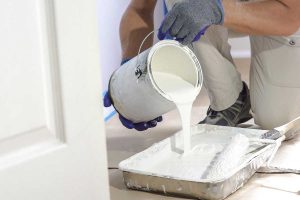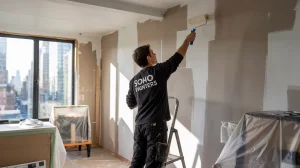In New York City, apartment painting isn’t just about aesthetics—it’s a legal obligation. Under the New York City Administrative Code, landlords must maintain their rental properties in good condition, which includes regular painting maintenance. This requirement ensures that rental units remain habitable and well-maintained, contributing to the overall quality of life for tenants while preserving property values.
The Three-Year Rule
The foundation of NYC’s painting requirements is the “three-year rule.” This regulation mandates that landlords must paint occupied apartments every three years, regardless of the paint’s current condition. The requirement applies to every room in the apartment, from bedrooms to bathrooms and kitchens. This mandatory schedule serves multiple purposes beyond mere appearance—it helps prevent wall damage, addresses moisture issues, and maintains proper sanitation standards.
Key points about the three-year rule:
- Must paint all rooms every three years
- Landlords bear all painting costs
- Requirement applies regardless of wall condition
- Cycle begins from the date of last painting
Exceptions to the Rule
While the three-year requirement is standard, the law recognizes that some situations warrant flexibility. Tenants can waive their right to painting if they agree in writing that their apartment doesn’t need it. Newly constructed or renovated units may also operate on a different schedule, as the initial paint job often maintains its integrity beyond the standard three-year mark.
It’s important to note that damage caused by tenants falls outside the scope of regular painting requirements. In these cases, landlords may address the damage separately and potentially charge tenants for repairs. However, this exception doesn’t release landlords from their obligation to maintain the overall condition of the apartment’s walls and paint.
Paint Quality and Safety Requirements
NYC takes paint safety seriously, particularly in older buildings. All paint used must be suitable for residential use and meet specific quality standards to ensure durability and safety. The city strictly prohibits the use of lead-based paint, reflecting decades of research on its health hazards. Buildings constructed before 1978 face additional requirements, including special lead paint disclosure and remediation rules that must be carefully followed during any painting work.
Professional application is equally important as paint quality. The work must be performed in a workmanlike manner, ensuring even coverage and proper preparation of surfaces. This professional standard helps prevent future issues such as peeling, bubbling, or uneven wear, which could necessitate additional work before the next scheduled painting.
Landlord Responsibilities and Tenant Rights
Landlords bear significant responsibilities in maintaining painted surfaces in rental units. They must not only schedule and coordinate painting every three years but also ensure the work is performed by qualified, licensed and insured professionals. This includes providing adequate notice to tenants before beginning work and maintaining detailed records of painting dates and work performed. Additionally, landlords must cover all costs associated with routine painting—these expenses cannot be passed on to tenants through rent increases or deductions from security deposits.
Tenants have specific rights regarding apartment painting that are protected by law. They can request painting when the three-year cycle is due and file complaints with the Housing Preservation & Development (HPD) if their landlord fails to comply. Tenants are entitled to receive adequate notice before painting begins, allowing them to prepare their living space and make necessary arrangements during the work period.
Enforcement and Compliance
The NYC Housing Preservation & Development takes painting requirements seriously and enforces them through various mechanisms. When landlords fail to meet their painting obligations, they may face violations and financial penalties. Repeated non-compliance can lead to more severe consequences, including legal action from tenants and negative impacts on building compliance records.
Building compliance history, which includes painting violations, can significantly affect a landlord’s ability to operate effectively in NYC’s competitive real estate market. Maintaining good standing with housing authorities through consistent compliance helps protect both the landlord’s reputation and their ability to manage properties successfully.
Best Practices for Implementation
Successful implementation of painting requirements demands careful planning and organization. Landlords should develop a comprehensive maintenance schedule that tracks painting dates for all units. This system should include regular inspections to identify any areas needing attention before they become significant issues.
Essential practices for effective compliance:
- Maintain detailed records of painting dates
- Document wall conditions before and after painting
- Keep written communications about painting arrangements
- Respond promptly to paint-related complaints
Conclusion
NYC’s painting requirements establish clear standards that benefit both landlords and tenants. While meeting these requirements requires careful planning and regular investment, they help maintain property values and ensure quality living conditions for tenants. Success lies in understanding the requirements fully, maintaining proper documentation, and addressing painting needs proactively rather than reactively.
Whether you’re a landlord or tenant, staying informed about these requirements helps ensure compliance and maintains positive relationships between all parties involved. If you are a landlord or a tenant that needs help painting your apartment, please don’t hesitate to contact Soho Painters for a free estimate!





